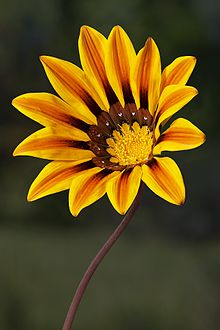Gazania

Gazania /ɡəˈzeɪniə/[3] is a genus of flowering plants in the family Asteraceae, native to Southern Africa.[4][5][1][6]
They produce large, daisy-like composite flowerheads in brilliant shades of yellow and orange, over a long period in summer.[7] They are often planted as drought-tolerant groundcover.
The genus was first formally described by German botanist Joseph Gaertner in the second volume of his major work De Fructibus et Seminibus Plantarum in 1791.[8] Gaertner named the genus after Theodorus Gaza, a 15th-century translator of the works of Theophrastus.[9]
Gazania is a member of the tribe Arctotideae and the subtribe Gorteriinae. Within the subtribe it is close to Hirpicium and Gorteria.[10] Many of the species of Gazania are hard to distinguish and the number of species assigned to the genus has varied widely from one author to another.
In 1959, Helmut Roessler published what he considered to be a preliminary revision of Gazania. At that time, he recognized 16 species.[11] Roessler published some amendments to his treatment in 1973.[12]
In 2009, a phylogeny of the genus was published. It was based on molecular phylogenetic analysis of chloroplast and nuclear DNA sequences.[9] In this study, all of Roessler’s species except Gazania othonnites were sampled. The authors found that eight species were not really separate, but formed a species complex. The seven species found to be distinct were G. jurineifolia, G. caespitosa, G. ciliaris, G. tenuifolia, G. heterochaeta, G. schenckii, and G. lichtensteinii.
The genus occurs from low-altitude sands to alpine meadows[7] in South Africa, Swaziland, Mozambique, Tanzania, and Angola.[8] Additionally, species are naturalised and declared weed in South Australia, New Zealand, the Mediterranean, and California.[8][13]
